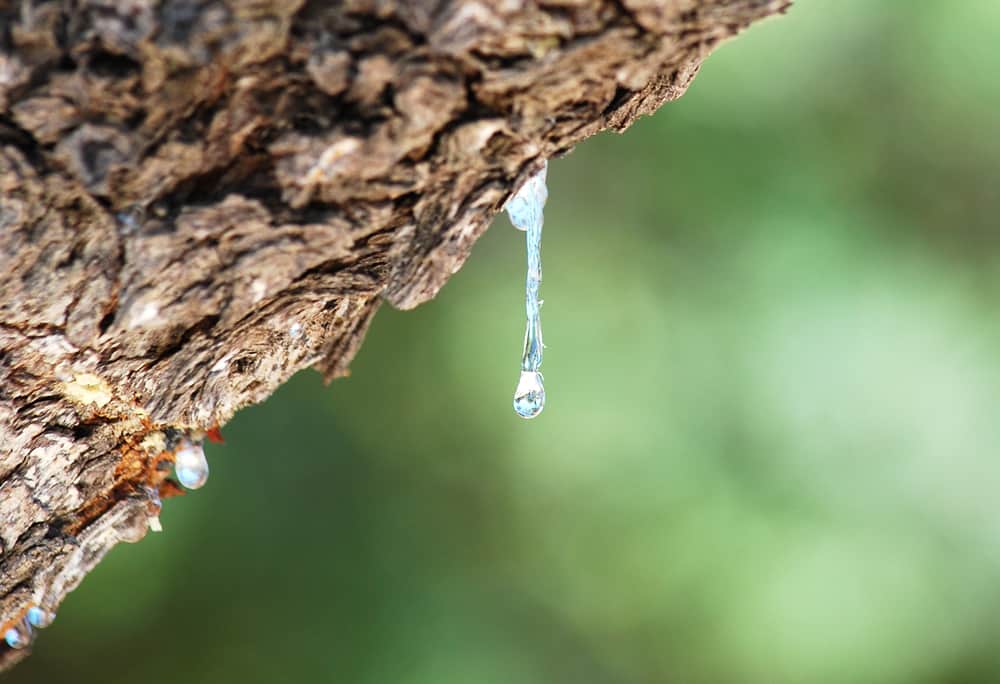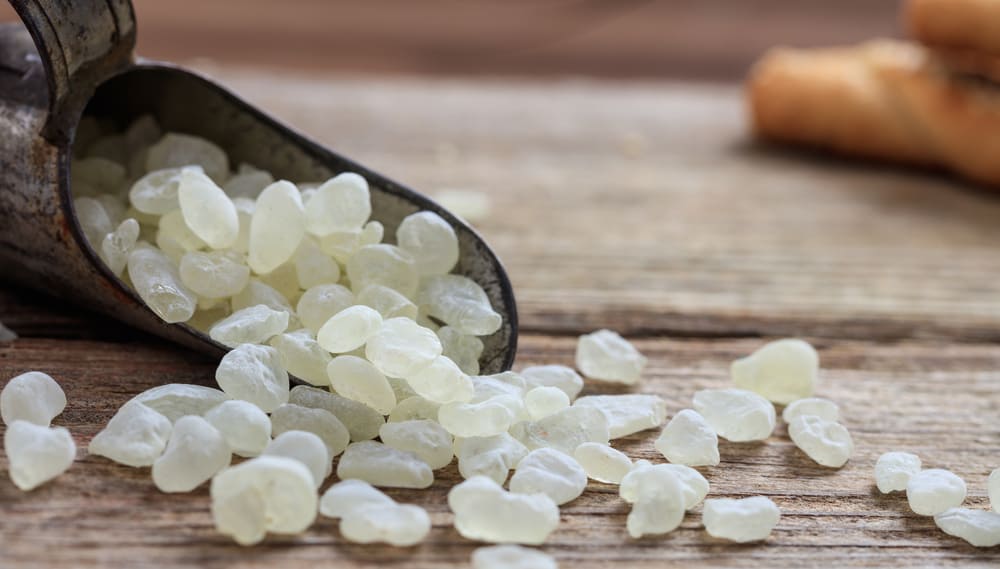Share this post
The things we know now about this gum that the Greeks have seen in practice for over 2,500 years
Ancient lore and cutting-edge science often converge in the arena of natural plant-based medicine. There is perhaps no better example of this than mastic gum, an aromatic, white resin derived from the Pistacia lentiscus tree. The gum was first noted by Greeks 2,500 years ago for culinary as well as medicinal applications, and praised by Pedanios Dioscorides, a physician and botanist who wrote the world’s first systematic pharmacopoeia, De Materia Medica, around 70 AD. [1],[2] The tree is actually an evergreen relative of the pistachio family native to the Greek Island of Chios in the wind-swept Aegean Sea, where the gum is referred to as “Chios tears.”
Mastic gum is a truly diverse botanical. Studies have shown mastic gum has antifungal and antibacterial activities, promotes wound healing, cholesterol reduction, and cardiovascular health.[3],[4],[5]
Mastic gum’s reputation in peptic ulcer disease
Peptic ulcers were long thought to be induced solely due to stress, and the typical treatment included the use of antacids.[6],[7] In 1983, however, Australian physician Barry Marshall and his colleague Robin Warren discovered that the bacterium Helicobacter pylori was the cause of many cases of chronic gastritis (inflammation of the stomach lining), peptic ulcer disease, and certain gastric cancers.[8] Marshall and Warren received the Nobel Prize in Physiology or Medicine for this remarkable discovery.[9],[10]
“Even low doses of mastic gum — 1 mg per day for two weeks — can cure peptic ulcers very rapidly,” they noted.
Though multi-pronged antibiotics are effective in eradicating H. pylori, antibiotics aren’t always well-tolerated and can cause significant alterations to the gut microbiome.[11],[12],[13],[14] In the late 1990’s, scientists reported in the New England Journal of Medicine on the benefits of mastic gum for six different strains of H. pylori infection: “Even low doses of mastic gum — 1 mg per day for two weeks — can cure peptic ulcers very rapidly,” they noted.[15] Another study found activity against nine strains of H. pylori along with other gram-negative and gram-positive bacteria.[16] And research continues, as in 2010, mastic gum was shown to eradicate H. pylori and alleviate symptoms of chronic gastritis and peptic ulcer disease.[17],[18]
Mastic gum for oral health
Mastic gum contains a surprising range of diverse and active plant compounds, many of which kill bacteria.[19],[20] Certain acidic fractions from mastic gum mimic antibacterial steroidal compounds.[21] The gum also has potent antiviral activity, including inhibition of herpes simplex virus (HSV).[22]
It is effective against Streptococcus mutans, the oral pathogen responsible for most tooth decay, as well as many other oral bacterial pathogens.
It’s interesting to note that the word “masticate” – meaning “to chew”- is actually derived from the term “mastic”. Natural mastic gum was used among ancient Greeks much in the same way as we use modern chewing gum, with the added advantage of beneficial health properties. It is effective against Streptococcus mutans, the oral pathogen responsible for most tooth decay, as well as many other oral bacterial pathogens.[23],[24] Studies show it can inhibit plaque formation and gingival inflammation.[25],[26],[27] The extract may thus be an effective and safe antibacterial agent in the prevention of periodontal disease.[28],[29]
Cardiovascular benefits of mastic gum
Mastic gum extract also can improve cardiovascular health by protecting low-density lipoprotein (LDL, or so-called “bad cholesterol”) from oxidation. LDL oxidation has been linked to kidney disease and diabetes, as well as atherosclerosis and many other cardiovascular conditions.[30],[31],[32],[33] In counteracting LDL oxidation, mastic gum has superior activity over other natural gums and resins.[34] Other studies have found that mastic gum can lower blood cholesterol and blood sugar, with no reported side effects.[35],[36]
Mastic gum extract also can improve cardiovascular health by protecting low-density lipoprotein (LDL, or so-called “bad cholesterol”) from oxidation.
Flavonoids and other compounds in mastic extract may also reduce the detrimental effects of smoking on the walls of arteries and linings of veins.[37] Pistacia lentiscus also has antioxidant properties, with the most effective compounds being extracted from the plant’s leaves.
A unique approach to wound healing
The sticky and pliable consistency of mastic gum has led to its use as a dressing for wounds, to help control heavy bleeding, and to accelerate healing.[38],[39] A skin adhesive has even been developed from mastic gum for use following surgical procedures. This adhesive is associated with fewer adverse reactions than other liquid adhesives used in surgery or wound management.[40],[41]
Summary
The astonishing diversity of medicinal and healing phenolic compounds, flavonoids, alkaloids, saponins, fatty acids, and sterols present in mastic gum show that this botanical’s long reputation as a natural healing agent is well deserved. Studies have shown that mastic gum may help eradicate H. pylori (linked to stomach ulcers) and Streptococcus mutans (linked to tooth decay). In addition, mastic gum extracts have been shown to diminish gingival and gut inflammation, reduce oxidation of LDL cholesterol, protect arteries and veins from smoking-related damage, and facilitate wound healing.
Click here to see References
[1] Paraschos S. Chios gum mastic: A review of its biological activities. Curr Med Chem. 2012;19(14):2292-302.
[2] Riddle JM. History as a tool in identifying “new” old drugs. Kluwer/Academic/Plenum Publishers, New York, 2002. Flavonoids in Cell Function, pp 89-94.
[3] Dimas KS, et al. Review: Chios mastic gum: a plant-produced resin exhibiting numerous diverse pharmaceutical and biomedical properties. In Vivo. 2012 Sep-Oct;26(5):777-85.
[4] Kartalis A, et al. G. Eur J Prev Cardiol. 2016 May;23(7):722-9. x Aug 26.
[5] Djerrou Z, et al. Afr J Tradit Complement Altern Med. 2010 Apr 3;7(3):258-63.
[6] Abbasi J. Barry Marshall, MD: H pylori 35 Years Later. JAMA. 2017 Apr 11;317(14):1400-1402.
[7] Fink G. Selye’s general adaptation syndrome: stress-induced gastro-duodenal ulceration and inflammatory bowel disease. J Endocrinol. 2017 Mar;232(3):F1-F5.
[8] Warren JR, Marshall B. Unidentified curved bacilli on gastric epithelium in active chronic gastritis. 1983. Lancet 321:1273-1275.
[9] Venerito M, et al. Helicobacter pylori, gastric cancer and other gastrointestinal malignancies. Helicobacter. 2017 Sep;22 Suppl 1.
[10] Marshall, B. Helicobacter connections. Chem Med Chem. 2006;1: 783-802.
[11] Wipperman MF, et al. J Antibiotic treatment for Tuberculosis induces a profound dysbiosis of the microbiome that persists long after therapy is completed. Sci Rep. 2017 Sep 7;7(1):10767.
[12] ASHP Commission on Therapeutics. ASHP therapeutic position statement on the identification and treatment of Helicobacter pylori-associated peptic ulcer disease in adults. Am J Health Syst Pharm 2001;58:331-7.
[13] Centers for Disease Control and Prevention. Knowledge about causes of peptic ulcer disease in the United States: March-April 1997. MMWR Morb Mortal Wkly Rep. 1997 Oct 24;46(42):985-7.
[14] Langdon A, et al.. The effects of antibiotics on the microbiome throughout development and alternative approaches for therapeutic modulation. Genome Medicine. 2016;8:39.
[15] Huwez FA, et al. Mastic gum kills Helicobacter pylori. New Eng J Med 1998;339:1946
[16] Francis NA, et al. Oral and Topical Antibiotics for Clinically Infected Eczema in Children: A Pragmatic Randomized Controlled Trial in Ambulatory Care. Ann Fam Med. 2017 Mar;15(2):124-130.
[17] Iauk L, et al. In vitro antimicrobial activity of Pistacia lentiscus L. extracts: preliminary report. J Chemother1996;8:207-9.
[18] Dabos KJ, et al. The effect of mastic gum on Helicobacter pylori: a randomized pilot study. Phytomedicine. 2010 Mar;17(3-4):296-9. 2009 Oct 29.
[19] Iauk L, et al. In vitro antimicrobial activity of Pistacia lentiscus L. extracts: preliminary report.J Chemother. 1996 Jun;8(3):207-9.
[20] Sharifi MS, et al. Bio-Activity of Natural Polymers from the Genus Pistacia: A Validated Model for Their Antimicrobial Action Glob J Health Sci. 2012 Jan; 4(1): 149-161. Published online 2012 Jan 1.
[21] Sharifi MS. Isolation, analysis and antimicrobial activity of the acidic fractions of mastic, kurdica, mutica and cabolica gums from genus pistacia. Glob J Health Sci. 2012 Jan; 4(1): 217-228.
[22] Suzuki R, et al. Evaluation of Biological Activity of Mastic Extracts Based on Chemotherapeutic Indices. In Vivo. 2017 Jul-Aug;31(4):591-598.
[23] Sakagami H, et al. Selective antibacterial and apoptosis-modulating activities of mastic. In Vivo. 2009 Mar-Apr;23(2):215-23.
[24] Oda Y, et al. Longitudinal study of dental caries incidence associated with Streptococcus mutans and Streptococcus sobrinus in patients with intellectual disabilities BMC Oral Health. 2015 Sep 2;15:102.
[25] Takahashi K, et al. A pilot study on antiplaque effects of mastic chewing gum in the oral cavity. J Periodontol. 2003 Apr;74(4):501-5.
[26] Keukenmeester RS, et al. The effect of medicated, sugar-free chewing gum on plaque and clinical parameters of gingival inflammation: a systematic review. Int J Dent Hyg. 2014 Feb;12(1):2-16.
[27] Aksoy A, et al. Short-term effect of mastic gum on salivary concentrations of cariogenic bacteria in orthodontic patients. Angle Orthod. 2007 Jan;77(1):124-8.
[28] Koychev S, et al. Periodontal. Antimicrobial effects of mastic extract against oral and periodontal pathogens. 2017 May;88(5):511-517.
[29] Paraschos S, et al. Chemical investigation and antimicrobial properties of mastic water and its major constituents. Food Chem. 2011 Dec 1;129(3):907-11.
[30] Ioan-Facsinay A, Kloppenburg M. Bioactive lipids in osteoarthritis: risk or benefit? Curr Opin Rheumatol. 2017 Oct 13.
[31] Kayıkçıoğlu M. Cardiovascular prevention and pitavastatin. Turk Kardiyol Dern Ars. 2017 Apr;45(Suppl 3):8-12. Turkish.
[32] Hermans MP, et al. The mixed benefit of low lipoprotein(a) in type 2 diabetes.Lipids Health Dis. 2017 Sep 12;16(1):171.
[33] Cesena FHY, et al. The Expected Cardiovascular Benefit of Plasma Cholesterol Lowering with or Without LDL-C Targets in Healthy Individuals at Higher Cardiovascular Risk. 2017 Jun;108(6):518-525. English, Portuguese.
[34] Andrikopoulos NK, et al. Biological activity of some naturally occurring resins, gums and pigments against in vitro LDL oxidation. Phytotherapy research. 2003 May 1;17(5):501-7.
[35] Gotto AM Jr. Evolving concepts of dyslipidemia, atherosclerosis, and cardiovascular disease: the Louis F. Bishop Lecture. J Am Coll Cardiol. 2005 Oct 4;46(7):1219-24.
[36] Kartalis A, et al. Effects of Chios mastic gum on cholesterol and glucose levels of healthy volunteers: A prospective, randomized, placebo-controlled, pilot study (CHIOS-MASTIHA). Eur J Prev Cardiol. 2016 May;23(7):722-9.
[37] Tsigkou V, et al. The impact of natural chios mastic supplementation on endothelial function and arterial stiffness in smokers JACC 2017 Mar:69, Issue 11.
[38] Khedir SB, et al. The healing effect of Pistacia lentiscus fruit oil on laser burn. Pharm Biol. 2017 Dec;55(1):1407-1414. Sep 23.
[39] Djerrou Z, et al. Effect of virgin fatty oil of Pistacia lentiscus on experimental burn wound’s healing in rabbits. Afr J Tradit Complement Altern Med. 2010 Apr 3;7(3):258-63.
[40] Hood CR Jr, et al. Liquid Adhesive Contact Dermatitis After Bunionectomy: A Case Report and Literature Review. J Foot Ankle Surg. 2016 Jan-Feb;55(1):209-14.
[41] Mikhail GR, et al. The efficacy of adhesives in the application of wound dressings. J Burn Care Rehabil. 1989 May-Jun;10(3):216-9.
The information provided is for educational purposes only. Consult your physician or healthcare provider if you have specific questions before instituting any changes in your daily lifestyle including changes in diet, exercise, and supplement use.
Share this post
Related posts
Mending the Leaky Gut
Natural strategies to support intestinal integrity My neighbor’s fence is beyond beautiful, but serves little to no practical purpose. With its widely spaced slats, the fence affords any passerby an only slightly fettered view of the yard and its goings-on. A cat, rat, or even small dog could easily pass back and forth across…
The Power of Echinacea
A natural alternative for sneeze and sniffle prevention Perhaps you know it for its distinct flower – a pronounced brown central cone, surrounded by delicate purple petals – and its common botanical name, purple coneflower. Or maybe, you know it as a natural remedy to take for protection against the sniffles and sneezes of…
Herbs for Female Libido Support
5 herbal remedies to rev a woman’s engine In the Greek myth, Tiresias struck two snakes in the act of mating and was himself then transformed from a man into a woman. When the Gods Zeus and Hera were later debating whether men or women experienced more pleasure during sex, they called upon Tiresias…
How the Microbiome Is Revolutionizing the Pursuit of a Healthy Life
What’s good for the microbiome is good for the body We often think of the human body as made of human cells, but it’s time to revise that perspective. As it turns out, the number of microbial cells in our bodies exceeds the number of human cells.[1],[2] We have ignored them far too long….
Pine Bark for Blood Vessels Big and Small, Part 2 of 2
A natural solution for erectile dysfunction, cold hands, and vision In Post 1 of 2, we explored the effects of maritime pine bark extract on blood pressure, hemorrhoids, and varicose veins. In this post we’ll zoom in on the extract’s effects on smaller blood vessels. Let’s take a closer look at the vascular diseases…
The Antiviral and Anti-Inflammatory Potential of Quercetin
The value of quercetin for respiratory health beyond allergies Quercetin is another well-known member of the polyphenol family. Considered a flavonoid type of polyphenol, quercetin is found in many fruits and vegetables, including onions, apples, cherries, broccoli, tomatoes, and berries, as well as green tea. We look to quercetin most often seasonally as a…
Categories
- Botanicals (56)
- GI Health (53)
- Healthy Aging (121)
- Immune Support (39)
- In The News (39)
- Kids Health (21)
- Stress and Relaxation (50)
- Uncategorized (1)
- Video (9)
- Vitamins & Minerals (51)





